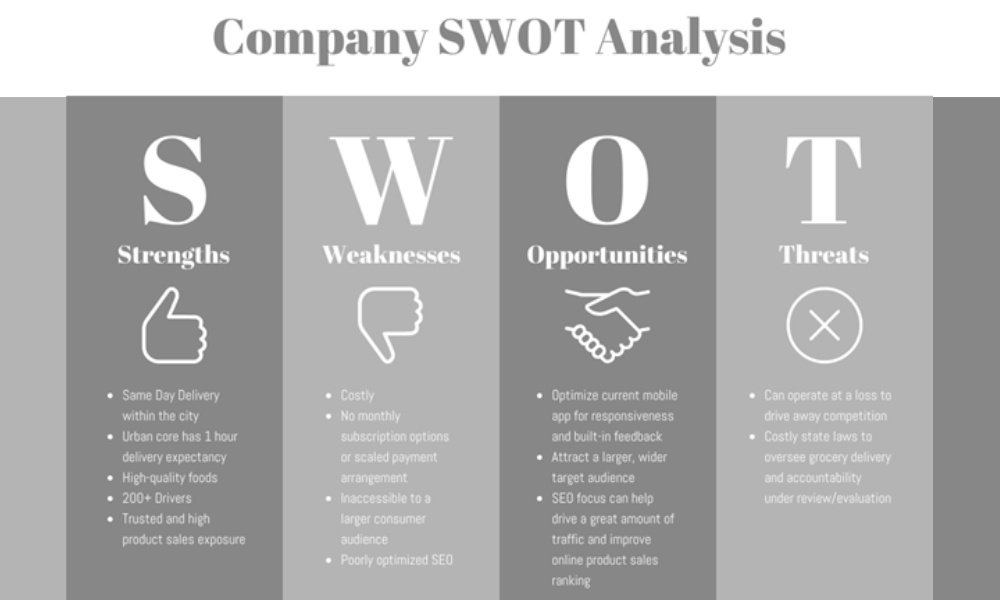A SWOT analysis template is a great way to reflect on the past year and assess your strengths, weaknesses, opportunities, and threats. It can help you identify areas for improvement and set goals for the coming year. Here are four steps to doing a successful year-end SWOT analysis:
1. Review Your Business Performance From The Past Year
This is where you sit down with your books and look at all the data you can about how your business performed during the past year. What made money? What didn’t? When are your busy times of year, and when do things slow down? This step should be fairly straightforward if you have been keeping up with your accounting reports throughout the year.
2. Examine Your Business Environment From The Past Year
Where do you need to focus your efforts? What big events took place during the past year that could affect how you’ll run things moving forward? How has your industry been affected by the economy? Has there been a technological development that you might need to factor into your business decisions? Think about how to best take advantage of any opportunities that presented themselves during the past year, and how to avoid or minimize potential threats.
3. Analyze Your Strengths And Weaknesses
What are your business’ strengths? What are its weaknesses? This is where you get a little more subjective, but it’s still important to be honest with yourself. Maybe your business is great at coming up with new ideas, but it’s not so good at following through on them. Or maybe you have a great relationship with your suppliers, but you’re not so good at dealing directly with the public. Include all of this in your business SWOT analysis template.
4. Identify Your Opportunities And Threats
What opportunities does your business have? What threats may impede your progress? A small business might see its location as an opportunity, or increased interest in one of its products. If you’re a natural foods store, for example, an increasing awareness of health-related concerns among consumers could be an opportunity. Threats might include a competitor opening up across the street, or an increase in the price of an important resource.
What are some areas in which your business could improve in the next year? Are there new products or services that would help you reach new markets? What about expanding your current offerings? What could potentially help your business grow in the next year? Are there any new regulations or laws that might benefit you? This is where you get to be creative in your company SWOT analysis template and come up with new ideas for how to grow your business.
5. Assess The Threats Posed To Your Business
What could potentially harm your business in the next year? Are there any new regulations or laws that could impact you negatively? Are there any new competitors in your market? Whether you use a paid or free SWOT analysis template, you should be able to identify potential risks and put together a plan to mitigate them.
6. Make Plans Based On Opportunities And Threats
This is where you make a plan for how to take advantage of your opportunities and avoid or mitigate your threats. For example, if you’ve realized that summer is a busy time for your business, and you’ve identified the opportunity to do more business during this time, then one of your goals might be to hire extra staff for summer. Or if you’ve realized that certain competitors have been stealing your business by selling at a lower price than you can afford, one of your goals may be to find ways to cut costs and sell at a competitive price.

7. Create Overarching Goals Based On Your Findings
Once you have completed your SWOT analysis template example, it’s important to set goals based on what you have learned. Maybe you want to focus on expanding your business into new markets, or maybe you want to work on developing better systems to manage your inventory. Whatever it is, make sure your goals are specific, measurable, achievable, relevant, and time-bound.
What can you do to capitalize on your strengths? How can you overcome your weaknesses? What can you do to take advantage of opportunities and mitigate threats? Write these down and make sure they are specific, measurable, achievable, relevant, and time-bound (S.M.A.R.T., for short).
With Venngage, you can make a SWOT analysis with a good layout.
8. Make Sure Your Goals Are Realistic
If you’re a small business with limited resources, it may not be possible for you to do everything on your list of goals. Prioritize and identify which goals will have the biggest impact on your business, and choose only those you can realistically achieve. Remember to leave room for plenty of flexibility so that you can adjust your goals as needed.
In Conclusion
In the end, SWOT analysis template examples is a great way to get organized and identify areas that need improvement or change. If you do it right, it should provide some very helpful insights into how your business operates and what changes might make your business more successful in the coming year.
Also Read: 4 Key Practices In Implementing Digital Transformation
















